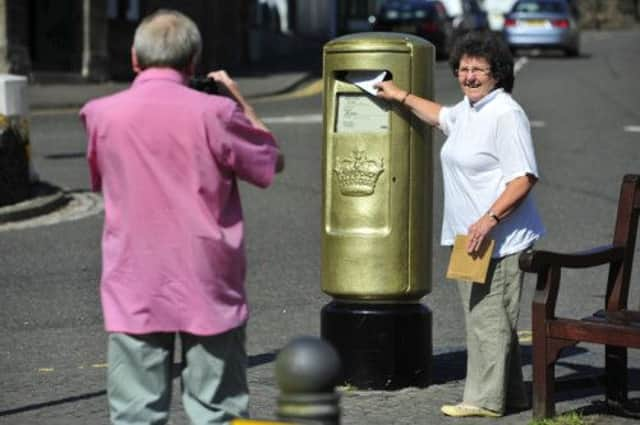Andy Murray magic puts Dunblane on tourist trail


But now a leading travel guide is promoting an “Andy Murray trail” of his home town, Dunblane.
The Stirlingshire town, with a population of just 9,000, has been singled out by Wanderlust magazine as a “must-see” destination to celebrate its most famous sporting son.
Advertisement
Hide AdAdvertisement
Hide AdWanderlust even names five “key sites” – many tongue-in-cheek – to be visited “to pay homage to the first British men’s Wimbledon tennis champion in 77 years”.
First on the list is the Atlantic Wall on Sheriffmuir Road. “Wondering where Andy Murray’s new-found fighting spirit has come from?” Wanderlust asks. “Most attribute it to [coach] Ivan Lendl’s gruff stewardship. But others suggest it could be the long-dormant influence of a childhood playing near the Atlantic Wall out on Sheriffmuir Road.
“Handily situated next to the Sheriffmuir Inn, this reinforced concrete mock-up of an anti-invasion Atlantic wall was used to test weapons as preparation for the attack on Normandy. It is clear that some of that D-Day spirit has remained.”
The second place to see is Leighton Library – Scotland’s oldest purpose-built library, founded on the collection of Robert Leighton, Bishop of Dunblane, 1661-70, later Archbishop of Glasgow, 1670-74.
“In his will, Leighton left a sum of money for the building of the library for use by the clergy of Dunblane diocese,” the guide says. “Dodging recent cuts in library funding, the library has survived to see Dunblane’s favourite son written into the history books, which can be found on the shelves at the back, right next to ‘twelve chairs of turkie red lether’, part of the original bequest,” adds the guide.
The golden postbox at the roundabout on the High Street is next up. It was painted gold in honour of Murray’s victory over Roger Federer in the London 2012 Olympics final.
“Murray himself quickly recognised it as a harbinger of things to come and bought the nearby Cromlix House Hotel,” quips Wanderlust.
Murray recently bought the hotel, where his brother Jamie held his wedding reception, for £1.8 million and is transforming it into a luxury 15-bedroom retreat in time for the 2014 Ryder Cup at Gleneagles.
Advertisement
Hide AdAdvertisement
Hide AdQueen Victoria’s Horseshoe is the fourth attraction on the trail. “At the corner of Bridgend and Stirling Road, just below the Bridgend sign is a horseshoe fixed to the wall,” the guide says. “This was from Queen Victoria’s horse when she passed through Dunblane. Her horse threw a shoe and the local blacksmith reshod it. The horseshoe was fixed to the wall in honour of this event and is said to bring all those who rub it good luck,” says the guide. “Reports of a tall figure in tennis gear lingering near it the night before the men’s final remain unsubstantiated,” it adds.
Finally, Doune Castle ends the trail. “Although not technically within Dunblane’s borders, this medieval stronghold in the nearby village of Doune still holds a strong sway over people of the area,” adds Wanderlust. “It was here that Monty Python shot their most influential work, Monty Python And The Holy Grail. Rumour has it that Andy used the insults [coined] by the French knights in that movie to put [Wimbledon final opponent Novak] Djokovic off his game.”
Moira Campbell, who runs Chimes House B&B in Kirk Street, said Murray’s win had already brought “scores and scores” of extra tourists.
“I have had to turn people away regularly,” she said. “Andy has done a lot of good for Dunblane. Tourists keep saying to me: ‘Isn’t it wonderful what he’s done.’ It is not just the B&Bs who have benefited – the coffee shops are full, business generally is doing well because of him and this new accolade is very welcome.
“Andy has helped Dunblane to be recognised for the right reasons and not for its unfortunate past events.”
A Stirling Council spokesman said Murray’s success had already sparked demand for extra car parking to cope with the tourists.
“The golden postbox has obviously been an attraction. Dunblane has become a special trip for people because of Andy and we hope this recognition by Wanderlust will bring even more,” she said.
Until Murray’s tennis triumphs – which include the US Open – Dunblane was notorious worldwide as the scene of the worst massacre of children in the history of the UK.
Advertisement
Hide AdAdvertisement
Hide AdMurray, who was born in Glasgow in 1987, grew up in Dunblane and was just eight when killer Thomas Hamilton stormed into his primary school to shoot dead 16 children and a teacher, before turning a gun on himself.
Murray, 26, spoke publicly about the massacre for the first time in a BBC documentary aired on the eve of this year’s Wimbledon championships and was reduced to tears before he uttered a word.
“Andy’s class were on their way to the gym, his class were the next ones in,” his mother Judy told the BBC. “I was one of hundreds of mums queuing up at the school gates waiting to find out what had happened, not knowing if your children were alive or not.”
Dunblane residents watched Murray’s Wimbledon victory in a community centre built with money donated in the wake of the massacre.
The butcher on the High Street was selling “Wimble-don!” sausages while signs reading “The boy done good” and “He did it for Dunblane” filled the windows.
The understated Murray told the BBC: “It is just nice being able to do something the town is proud of.”